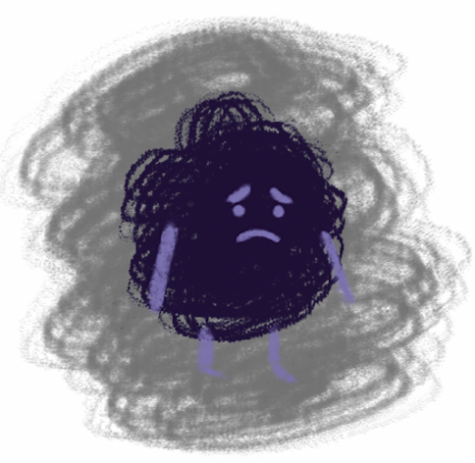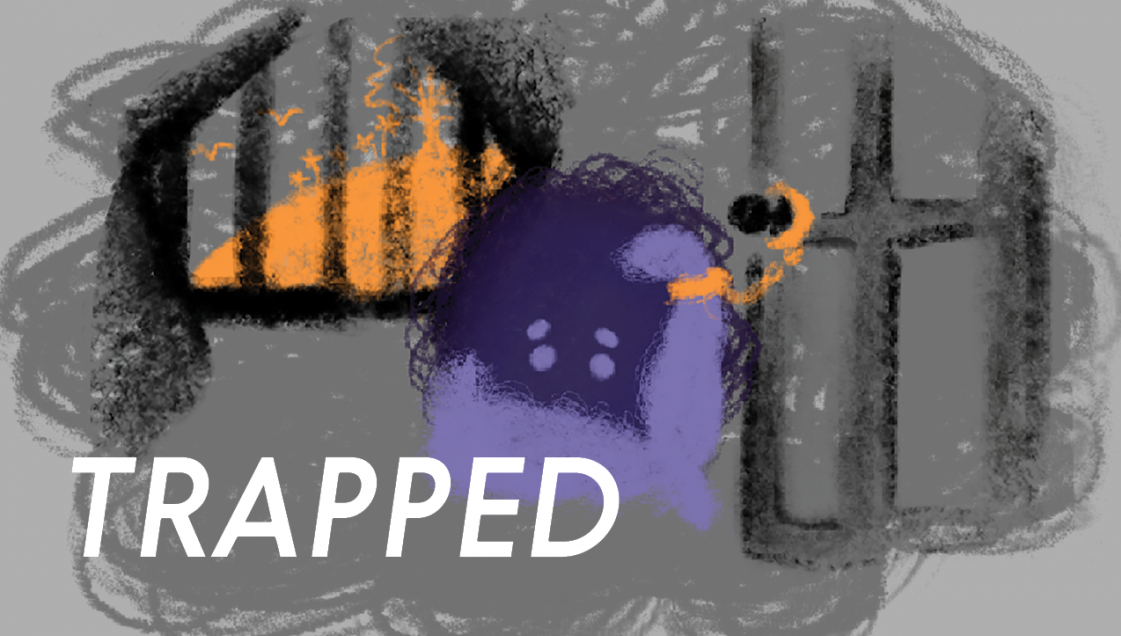Your donation will support the student journalists of West High School. Your contribution will allow us to purchase Scholarship Yearbooks, newsroom equipment and cover our annual website hosting costs.
Trapped
WSS takes a look at how isolation due to social distancing is affecting the mental health of students.
May 21, 2020
Six feet. That’s the distance every person is recommended to stay physically apart from others, according to the CDC. Although social media and other online communication methods can partly fulfill the sense of isolation, some may believe seeing a friend over a screen simply isn’t the same as in-person. This feeling of separation often has an impact on a person’s mental health.
Pre-existing mental health conditions such as depression and anxiety disorders can be affected in many ways. For some, the time alone is a time to relax, reflect and move away from the everyday things that cause them stress. However, for others, physical connection and routine can be their best coping strategies. On top of already existing mental health disorders, the idea of possibly contracting or unknowingly spreading COVID-19 can be enough to make anyone feel anxious. As days pass and deadlines no longer seem real, finding motivation to get out of a slump can be a daunting task.
Hidden symptoms
Due to this pandemic, most schools and businesses are shut down, keeping many families at home. This situation is not ideal for some students who suffer from depression and anxiety.
“I can definitely feel there’s some steepness going down to it, where it’s like you can feel yourself slipping back into the darkness that is depression and anxiety,” said Holden Logan ’21.
For Maia DeGrazia ’20, social distancing has brought her back to difficult past experiences. In May of 2019, DeGrazia underwent spinal fusion surgery. She faced a six month recovery process, the first months following the surgery being summer vacation. While many of her peers were away on trips, DeGrazia was forced to remain at home.
“It’s been kind of hard just because the last time I was this isolated was after my surgery [and] those were some really difficult months of my life,” DeGrazia said. “I’m definitely finding myself being taken back to that place with this isolation, which can be really problematic with panic attacks and things because I don’t want to go back to where I was.”
Loads of unknown facts and new information about the virus are constantly floating around the world everyday. According to DeGrazia, this adds another stress factor to students’ daily lives.
“Just dealing with the weight of the rest of the world and hearing about everything going on, it’s really hard to not feel that hurt in your heart, even though it’s not happening to you,” DeGrazia said. “I sort of feel like I have my own issues, but then I’m also feeling very deeply the hurt the rest of the world is feeling.”
Without school bells ringing at precise times prompting students to transfer from one class to another, it can be problematic for those relying on a structured day. This absence of a schedule makes Caroline Mascardo ’22 feel insecure about how she spends her time each day.
“I feel like I am not doing enough, and there are a lot of things that are going on,” Mascardo said. “It’s tough for me to feel satisfied with how I spent the day, if I could have done more or if I wasted time doing something that I could have [spent time] on other subjects.”
On a typical school day, over 1 billion children in the world head to school. Currently, around 91% of students worldwide are staying home from school to prevent the spread of the virus, according to UNICEF. With classrooms empty, students were abruptly handed large amounts of free time. For Logan, as hours pass by, the increased amount of free time turns into boredom.
“Boredom leads you to even darker places, so the main thing that’s been a struggle is trying to keep myself entertained,” Logan said. “Whenever I do get bored, I have to kind of catch myself before I can slip nearly as deep as I used to, which now for me has gotten quite easier, but I still get a little bit into the darkness.”
DeGrazia shares the sentiment that finding motivation and being productive during isolation has been difficult.
“Personally [isolation has] been pretty difficult, I definitely find it hard to get motivation to do anything, [and] I don’t feel a lot of purpose. I want to do things and then I don’t really see a reason why because nothing really seems relevant anymore,” DeGrazia said.
Physical isolation from others has caused DeGrazia to have depressive thoughts more frequently than before.
“When something like this happens, and we are isolated, it’s really, really easy to fall into a depressive state, get very, very anxious [and] spend a lot of time worrying because … if you have anxiety, for example, it’s just your brain is overly productive sometimes,” DeGrazia said.
As the social distancing guidelines are extended and isolation continues into the summer months, Logan worries his condition will become unstable.
“I think it’s gonna be like waves, it’s gonna go up and down throughout this whole thing. I definitely feel like there’s gonna be points where it’s gonna be extremely easy to handle and there’s going to be points where it’s going to be extremely hard to handle, but that’s kind of what you have to learn to deal with,” Logan said.
The pandemic has caused temporary closures of restaurants and schools, and Logan also believes it will reshape society in the long-run.
“There are definitely going to be some societal aspects that are going to change, whether it’s gonna be permanent or temporary. Some of the things like washing your hands more often [and] wearing a mask, that might become more commonplace even after all of this is over,” Logan said.
Due to the outbreak of the virus, upcoming plans and what the future looks like has become a blurry image, especially for seniors who are attending college in the fall.
“I think it’s less about the virus being invisible and more about all the unknowns that come with it and how it’s affecting our daily lives but then also our future. It was really hard when the French trip, which was the one thing I was looking forward to, was canceled, and not knowing if I’m going to college in the fall is really stressful,” DeGrazia said. “We don’t know what’s happening, and so not feeling in control and just not knowing what the future is going to look like is probably the scariest part and the most stressful part, not the virus itself.”
The social media situation
In a time where many are isolated, social media can be one of the only ways to stay caught up with the lives of the people one would have used to see at school everyday. But of course, that connection is distorted. What’s seen and posted on social media is often referred to as the highlight reel of one’s life. Instagram feeds can be filled with beautifully crafted salads and brightly colored smoothies as people hide the large pizza and pint of ice cream they ate. This forcefully gilded trend hasn’t changed much under social distancing.
“Research shows social media frequently portrays images that emphasize appearance and are unrealistic for the majority of people,” said Dr. Melinda Green, a professor of psychology at Cornell College. “If someone is struggling with anxiety, depression, an eating disorder, or low self-esteem, he or she may compare themselves to these images in an unfavorable way and feel like they don’t measure up.”
Opening Instagram can mean coming across the seemingly perfect life of a celebrity, and the “For You” page of TikTok is filled with fitness transformation videos. The feeling that one must come out of this time of social distancing a changed person often leads to negative self thoughts and sometimes dangerous exercise habits.
“For me personally, it’s very toxic right now because every social media platform I opened is talking about quarantine weight gain, the quarantine 15 workouts that you do, eating healthy, ‘let’s glow up this quarantine,’” said Emma Selby ’22. “It’s kind of frustrating because I think everyone is obviously different, everyone’s body is different, everyone’s needs are different, so I appreciate people who want to share what works for them because if it can help someone else that’s really helpful, but I think it can also be really triggering to people with eating disorders, especially during this time.”
 The constant talk on the internet about gaining weight during social distancing also frustrates Sam Croco ’22.
The constant talk on the internet about gaining weight during social distancing also frustrates Sam Croco ’22.
“Quarantine has definitely not helped my body image. Sitting in my bed watching video after video and seeing picture after picture of a girl who I would give so much to look like really sucks. I struggle with motivation to do a lot of stuff, so forcing myself to workout 20 minutes a day is a struggle,” Croco said.
Lack of motivation is common whilst social distancing, when time doesn’t feel relevant and the days start to mold together. Making a routine and sticking with it can be a difficult task but has proven to be an effective coping strategy for those who feel they need more structure throughout their days.
For students struggling with body image conditions, isolation can be especially hard. On top of this feeling of isolation, seeing what seems to be “everyone” exercising and eating healthy can easily make any person feel the need to do the same. To reduce the amount of stress and anxiety, Green recommends to occupy time with uplifting tasks.
“Find activities that reduce your anxiety and give you a sense of worth. Connect with others who make you feel heard, understood, loved, and accepted. Identify ways to celebrate life even on days you are experiencing high levels of anxiety and doubt. Remember that the body does not react well to extreme rules or restrictions. It is hard to love and accept the self if you are engaging in behaviors that are punishing,” Green said. “Pay attention to how you feel after eating or exercising rather than paying attention to numbers. Do things that make you feel good and have positive outcomes [and] remember you are not alone and seek out others for support on hard days.”
Due to social distancing and quarantine in other states, lots of fitness bloggers and YouTubers are releasing free workout programs and advertising their meal choices on social networking sites.
“The worst part about it is that I know no matter how much I do, I will never look exactly how I want to look. I’ve gone through a lot of stuff because of this feeling, from skipping meals to over exercising, but that isn’t a healthy way to feel better about my appearance,” Croco said. “What I’ve been doing a lot lately is looking up videos about body positivity and seeing so many beautiful girls talking about how everybody is beautiful and how they have learned to love themselves over the years. That doesn’t automatically solve my negative feelings towards myself, but I feel like it’s a start.”
Seeing improvements
While others may feel anxious during this unpredictable time, Teya Kerns ’20 has found it to be a way to reset herself.
“Regarding my anxiety it has all been positive, but I expected that. I always do better when I’m not at school, but if I’m missing school and everyone else is there then I start to worry about that. It’s really a never ending cycle. I always say that I just need the world to freeze for a bit, so I can catch up and figure things out,” Kerns said.
The Iowa City Community School District originally offered optional learning and enrichment activities for students who wished to participate. Starting April 27, the district switched to a mandatory learning plan. Since classes and school work have been shifted from the classroom to online, it has been convenient for Kerns.
“With COVID-19 moving everything online, my anxiety has improved so much. On Zoom calls I can turn off my video so I know no one is watching me, and I can learn without my head buzzing about all the people around me,” Kerns said. “I always get frustrated in school when teachers just ramble during class time. Having limited class time, I just have to listen to a lecture, and then I’m able to do the work at my own pace. Making my own schedule has allowed me to build in more time to take breaks when I start to freak out, and being at home I’m able to get up and leave when I need to.”
Student Family Advocate Jamie Schneider believes the absence of school in students’ daily lives can lift some weight off a student’s shoulder.
“We are seeing kids that we would see almost on a daily, sometimes weekly basis [at school], their stress is not as high as it is if they were in school seven periods a day. The drama with friends, the drama with boyfriends and girlfriend[s], just the overall stress that high schoolers have in their day, kind of just went away overnight,” Schneider said.
According to Assistant Principal Molly Abraham, the ICCSD avoids adding additional stress to students by having a flexible curriculum and asking teachers to reduce the amount of work for mandatory learning to three hours for each subject per week.
“We really wanted teachers to focus on the essentials that were really important. We didn’t want to overwhelm kids,” Abraham said. “I think everybody’s trying pretty hard to be flexible with kids and understand we have to meet kids where they are and what they can do in this strange setting.”
This adaptability the district is offering is something Kevy Huynh ’23 recognizes and appreciates.
“I know a lot of teachers are already being supportive of students, and they’re trying to assign a doable amount of work without overwhelming us. That’s something I’m really thankful for, it shows that teachers understand or are doing their best to understand our situations,” Huynh said.
Dr. Patricia Espe-Pfeifer, a clinical professor of psychiatry and pediatrics at the University of Iowa, believes improvements in anxiety symptoms during this time is not out of the ordinary.
“We also have some kids that struggle with anxiety symptoms that now that they’re at home, surprisingly, [are] doing pretty well. They may not have the stress of school, since a lot of it has been optional. They’re able to kind of navigate on their own, so [mental health situations] just really depend,” Espe-Pfeifer said.
A helping hand

To help with the feeling of isolation and the effects it has on a person’s mental health, the CDC recommends staying connected with others and sharing how you are feeling to a family member or friends. For Logan, having people to talk to is a reliever and helps improve his mental state.
“Being able to open up to someone [with] no judgement about it, it’s really nice. You’re able to get all of your emotions out in a positive way. You’re able to communicate how you’re feeling, and then you’re able to deal with it,” Logan said.
Unlike physical health, mental health conditions can go unseen. According to Kerns, some people don’t notice her condition, and it’s difficult to find others who are in the same position as her.
“The thing with something like anxiety is you never know who has it. Oftentimes when people find out I have anxiety, they are surprised. At school I’m outgoing and I take on leadership roles. What people don’t realize is I go home and analyze everything I did or said that day and worry that I messed up. I’m good at hiding my anxiety, and other people are too, so it’s hard to find those similar to me,” Kerns said.
Without knowing the condition of others, it makes the tasks of identifying a peer’s mental health disorder more complicated. To combat this, DeGrazia recommends staying in touch with your peers.
“When you’re not being forced to see people, it’s really easy to just be like, ‘I’m just gonna block myself off from the world’ and that’s not good for anyone, you don’t want to keep it all in,” DeGrazia said. “Talk to somebody about it, so it’s good to encourage that and just check in [with others].”
At West, Student Family Advocates Schneider and John Roarick offer many mental health services at the guidance office. Due to school closures, this is no longer possible. However, these resources are being offered in a new, virtual form.
“All of us in guidance are available by email and we even have ’email office hours’ twice a week. During this time we are immediately available to communicate back and forth with students through email about any of their mental health, academic or social emotional concerns,” Roarick said.
Other services such as Zoom and phone calls are offered. The guidance office is making sure there are as many resources available to students as possible.
“I would say we would do a lot of crisis intervention, just a lot of informal check-ins [and] those types of things, but one of the things that we really love doing is connecting students with mental health resources,” Schneider said.
At first, DeGrazia was hesitant to step into the guidance office to receive mental health therapy, but looking back she does not regret her decision.
“I think that kids should take more advantage of it, because to be honest I think everybody needs a therapist at some point in their lives, just like we go and we get checkups at the doctor. I think there’s just kind of a stigma around it, which I’m guilty of even kind of falling [into] because it was really hard for me to go, especially the first time, I felt embarrassed and ashamed. But I didn’t need to be … it was great,” DeGrazia said.
Special Education Teacher Rick Hancox is the keeper of the Student Self-Care and Support Circle, a way for students to connect with others and feel a sense of community during this isolated time. Hancox sent an email to all West students April 28 to survey their interest in participating in these structured conversations with others. For the past three years, the circle was for staff members and occasionally some students. Now it has expanded to the whole student population during this time of social distancing.
“Being with friends and hanging out and seeing them at lunch and having those conversations are really important. And even teachers in the building: we’re learning, and I’ve learned personally I’ve taken for granted some of the relationships that I had [and] that I depended upon during my day [that] there aren’t anymore, so there’s these gaps in these holes and I think circle is a way to help fill those gaps and allow people to reconnect again and just people’s company,” Hancox said.
Providing an environment for students to share their thoughts during social distancing can ease a student’s mental health condition.
“[Keeping your feelings in] is like an invisible bag of bricks, but when you’re able to lay your trust and your relationship with [someone] and you share those bricks, your load is actually lighter. Sometimes those bricks disappear, there are times you learn how to carry them differently to your benefit as opposed to you feeling like you’re isolated,” Hancox said.
While society and daily lives have been drastically transformed, supporting and helping others should not change during this time.
“I think it would be the same as if you were in person and life was going on as normal. If you felt like your friend was struggling, ask them if they are. I think that’s the first step,” Espe-Pfeifer said. “They may be feeling a lot of the same emotions and frustrations that you’re feeling and help them problem solve and help them. If you feel like you can’t help them do that, then ask their permission to help them talk to somebody, whether it’s one of their family members, trying to research what some different resources might be and just letting them know it’s okay to be struggling right now, because all of us are having those moments. This is new for everybody.”
When a student sees their peer having a difficult time, Guidance Counselor Greg Yoder recommends checking in with the student and making sure they know they aren’t alone in their difficulties.
“Just encourage students, if there’s a struggle that they are having, reach out to someone [such as] a trusted adult. If there’s a problem taking place in the home, reach out to a teacher that they trust or counselor. If their family’s experiencing some difficulties, just make sure that you’re reaching out,” Yoder said. “There’s no reason that a student has to go through this stuff alone. As educators, we want to see that everybody is well and is taken care of, and we want to be there to assist.”
West is still offering many mental health services despite the school closure, but students can also reach out to their peers as they are only a text or phone call away. These seemingly small and effortless actions can have a big impact for those who need the support.
“The one thing that triggers off a good [moment] is really any kind of act of kindness,” Logan said. “[It] is just the small things people do … simple things can help a lot.”


